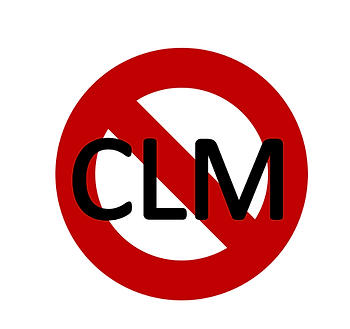Don't Buy a CLM
 Contract Lifecycle Management (CLM) tools are all the rage. Consultants are recommending them. Commercial contracting trade associations advocate for them. Your LinkedIn feed is likely full of marketing ads for them. And lots of companies claim to have implemented a CLM, to be in the process of implementing a CLM, to be evaluating CLMs, or to have plans to do all of this in the near future.
Contract Lifecycle Management (CLM) tools are all the rage. Consultants are recommending them. Commercial contracting trade associations advocate for them. Your LinkedIn feed is likely full of marketing ads for them. And lots of companies claim to have implemented a CLM, to be in the process of implementing a CLM, to be evaluating CLMs, or to have plans to do all of this in the near future.
But you probably shouldn't buy a CLM. At least not yet. You're not ready.
CLMs are wonderful tools that promise loads of benefits. Reduced risks. Governance. Efficiency. Standardization. Accuracy. Visibility. Automation. Integration. Collaboration. Analytics. Reporting. Certainly, we want all these benefits that a CLM can give us! Contracts are a nuisance – painful to create, negotiate, approve, execute, store, and manage. But a CLM by itself is not a silver bullet.
You're not ready to buy a CLM until you can answer these questions:
1. What problem are you trying to solve?
Do you just need to get all your contracts in one place? Do you need the ability to report on and analyze your contracts? Do you want to standardize and automate the contract creation process? Are you hungry for workflow and governance to route contracts for approval? Do you want artificial intelligence to help you extract data from your contracts? If you're just getting your contracts organized, then a simple repository might be enough for you. But if you're looking to take your contracting function and processes to the next level, then you likely need a robust CLM that can serve you through the entire contract lifecycle.
2. What other systems do you expect to integrate with your CLM?
If you already have systems in place that are deeply embedded in the way you work, you may want to integrate your CLM with these systems. Think about the financial systems you use for purchasing, billing, planning, and regulatory reporting. Consider the software you use for internal collaboration like e-mail, instant messaging, calendars, and shared files. And don't forget any tools that are critical to your operations. Do you want to integrate contract information with any of these other systems? At a minimum, you should be able to extract relevant data from your CLM and import it into other appropriate tools.
3. Who will "own" the CLM?
This is often a sensitive subject, but someone needs to be in charge. Who will be the primary stakeholder for your CLM? Is it Legal, Procurement, Sales, Finance, or someone else? Whose budget is paying for it? Who will be responsible for defining the CLM requirements? Who will be the primary users – or consumers – of the information in the CLM? My own view is that the proper owner of the CLM is NOT the IT department, or Legal, or Finance. These groups are important voices to be heard, but they are supporting functions. Instead, I recommend that the owner be the group whose contracts are going in the CLM. That group should care the most about how and where they will access the information that is critical to their business.
4. Do you have resources allocated to implement and operate the CLM?
Implementing a CLM is not a side project. It is not something you should ask your best people to do in addition to their day jobs. It will take time, money, and people to do it correctly. Budget accordingly. And once the CLM is implemented, you will need skilled people in place permanently to manage the CLM and the data in it. Otherwise, all your effort will be wasted. Consider establishing a dedicated team to manage your contracts and your CLM. At LegalSifter, this is a service we provide. Learn more about this service here. And I recommend that you read this white paper by LegalSifter's CEO, Kevin Miller.
5. How will you get your existing contracts into the CLM?
Every company implementing a CLM eventually faces this pivotal question: what about all the contracts we already have? How will these contracts and their associated metadata get into our new CLM? You could ask your internal teams to read through all their contracts, extract the data, and enter it into the CLM. Good luck with that! You could hire temporary support staff or a consulting firm to do the same thing. It will be slow and expensive. Or you could leverage the combined power of artificial intelligence and human expertise to extract the data for you. That's one of the things we do at LegalSifter. We'd love to help you solve this challenge.
6. What is your change management plan?
Your company already has a method for managing its contracts. It may not be a good way. It may not be intentional or structured or even consistent across the organization. But your contracts are somewhere! They're in desks, file cabinets, or a myriad of hard drives. Successful implementation of a CLM will require effective change management. Is your leadership team on board with this new approach? Do you have a clear story "why" a CLM is needed? Are you prepared to create and implement new contracting processes? Who will train your teams? Who will enforce compliance with new ways of working? Don't underestimate the difficulty and importance of breaking through the inertia of "that's how we've always done it" and the natural resistance to change.
********
There are over 200 CLMs available in the market today, with a wide range of features, functionality, and cost. Finding a CLM that you like and that you can afford is not going to be difficult. Unfortunately, a staggering percentage of CLM implementations will fail – and it's probably not going to be the CLM provider's fault. Too many companies rush into a CLM purchase, enamored by the shiny bells and whistles, and by the promised benefits. But they fail to do their homework first. They fail to prepare and plan. And they haven't answered these six questions. Don't do it! Don't buy a CLM until you're ready.





